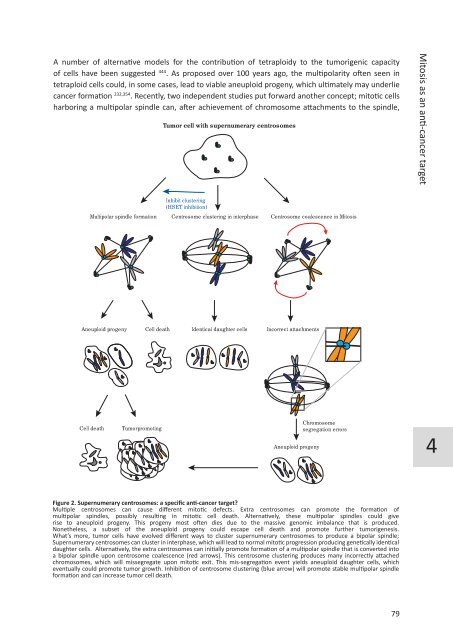Chromosome segregation errors: a double-edged sword - TI Pharma
Chromosome segregation errors: a double-edged sword - TI Pharma
Chromosome segregation errors: a double-edged sword - TI Pharma
You also want an ePaper? Increase the reach of your titles
YUMPU automatically turns print PDFs into web optimized ePapers that Google loves.
A number of alternative models for the contribution of tetraploidy to the tumorigenic capacity<br />
of cells have been suggested 444 . As proposed over 100 years ago, the multipolarity often seen in<br />
tetraploid cells could, in some cases, lead to viable aneuploid progeny, which ultimately may underlie<br />
cancer formation 232,354 . Recently, two independent studies put forward another concept; mitotic cells<br />
harboring a multipolar spindle can, after achievement of chromosome attachments to the spindle,<br />
Multipolar spindle formation<br />
Aneuploid progeny<br />
Cell death<br />
Cell death Tumorpromoting<br />
Tumor cell with supernumerary centrosomes<br />
Inhibit clustering<br />
(HSET inhibition)<br />
Centrosome clustering in interphase Centrosome coalescence in Mitosis<br />
Identical daughter cells<br />
Incorrect attachments<br />
Aneuploid progeny<br />
<strong>Chromosome</strong><br />
<strong>segregation</strong> <strong>errors</strong><br />
Figure 2. Supernumerary centrosomes: a specific anti-cancer target?<br />
Multiple centrosomes can cause different mitotic defects. Extra centrosomes can promote the formation of<br />
multipolar spindles, possibly resulting in mitotic cell death. Alternatively, these multipolar spindles could give<br />
rise to aneuploid progeny. This progeny most often dies due to the massive genomic imbalance that is produced.<br />
Nonetheless, a subset of the aneuploid progeny could escape cell death and promote further tumorigenesis.<br />
What’s more, tumor cells have evolved different ways to cluster supernumerary centrosomes to produce a bipolar spindle;<br />
Supernumerary centrosomes can cluster in interphase, which will lead to normal mitotic progression producing genetically identical<br />
daughter cells. Alternatively, the extra centrosomes can initially promote formation of a multipolar spindle that is converted into<br />
a bipolar spindle upon centrosome coalescence (red arrows). This centrosome clustering produces many incorrectly attached<br />
chromosomes, which will missegregate upon mitotic exit. This mis-<strong>segregation</strong> event yields aneuploid daughter cells, which<br />
eventually could promote tumor growth. Inhibition of centrosome clustering (blue arrow) will promote stable multipolar spindle<br />
formation and can increase tumor cell death.<br />
79<br />
Mitosis as an anti-cancer target<br />
4













